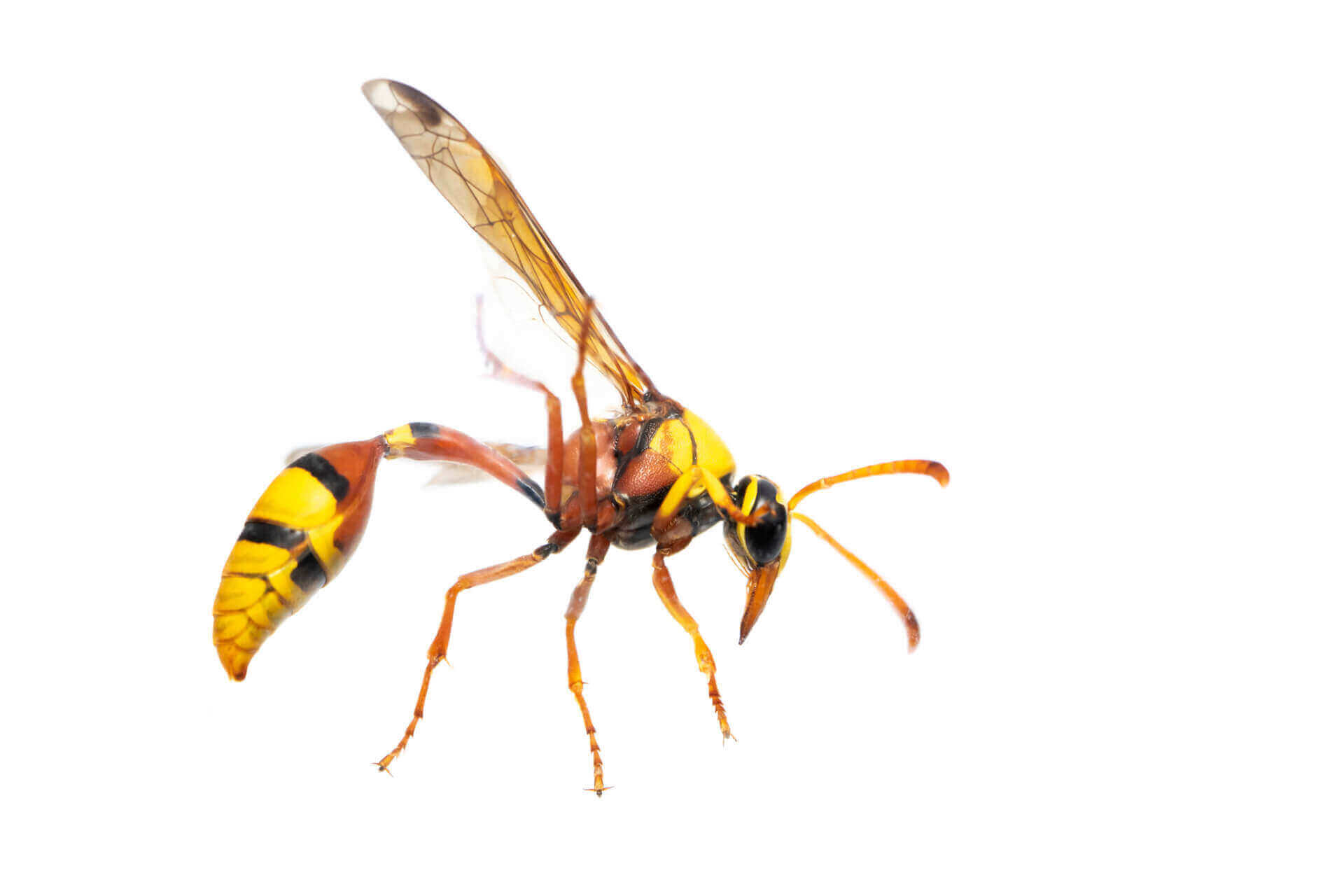Mud Dauber Facts & Information
Everything you need to know about mud daubers
what do Mud Daubers look like

Mud daubers are solitary wasps and do not form colonies like yellow jackets, hornets, and paper wasps. They overwinter in their nests as larvae and emerge as adults in the spring. Nests with holes drilled in their sides are inactive and empty. Mud daubers are usually black, but they may have pale markings or a blue metallic luster. The mud dauber has a thread-waisted body, meaning there is a long, slender segment between the thorax and abdomen. Mud daubers also possess clear or dark wings.
Finding a nest is the most common sign of a mud dauber infestation. The shape of the mud dauber nest is a key indicator of the wasp group. For example, female black-and-yellow mud daubers will construct their nests of many short mud tubes measuring about 1″ long that are built side-by-side. On the other hand, the organ pipe mud dauber constructs a nest comprised of many long mud tubes that resemble pipes on a pipe organ. In general, most mud daubers will select a new site to build a nest for each generation. If the nest has holes, it may indicate that the nest is inactive or old, as mud dauber wasps create holes when they leave the nest. Mud daubers are not aggressive and are unlikely to sting. Still, care should be taken in the presence of an abandoned mud dauber nest, as other, more aggressive insects may take it over. If you do have these wasps around your home, you may want to bring in a wasp exterminator to start the mud dauber removal process.
Mud daubers undergo complete metamorphosis, which means they pass through four stages during their lifecycle – egg, larvae, pupae (cocoon), and adult. Depending on the species, they complete one or two generations per year. In the spring, overwintering pupae develop into the adult. The new adult females will construct nests comprised of mud tubes of varying sizes. Each mud tube is provisioned with several spiders that the female mud dauber catches and paralyzes with her venom. The female mud dauber deposits an egg on the first spider within each mud tube and then seals them with mud. The mud dauber larvae will hatch from the eggs and feed on the prey left behind by the adult female mud dauber. Then, the larvae will develop into pupae, a process that usually takes about three weeks. The pupae will spin a silk cocoon to overwinter until the following spring when they become adults.Not the wasp you have?
Finding a nest is the most common sign of a mud dauber infestation. The shape of the mud dauber nest is a key indicator of the wasp group. For example, female black-and-yellow mud daubers will construct their nests of many short mud tubes measuring about 1″ long that are built side-by-side. On the other hand, the organ pipe mud dauber constructs a nest comprised of many long mud tubes that resemble pipes on a pipe organ. In general, most mud daubers will select a new site to build a nest for each generation. If the nest has holes, it may indicate that the nest is inactive or old, as mud dauber wasps create holes when they leave the nest. Mud daubers are not aggressive and are unlikely to sting. Still, care should be taken in the presence of an abandoned mud dauber nest, as other, more aggressive insects may take it over. If you do have these wasps around your home, you may want to bring in a wasp exterminator to start the mud dauber removal process.
Mud daubers undergo complete metamorphosis, which means they pass through four stages during their lifecycle – egg, larvae, pupae (cocoon), and adult. Depending on the species, they complete one or two generations per year. In the spring, overwintering pupae develop into the adult. The new adult females will construct nests comprised of mud tubes of varying sizes. Each mud tube is provisioned with several spiders that the female mud dauber catches and paralyzes with her venom. The female mud dauber deposits an egg on the first spider within each mud tube and then seals them with mud. The mud dauber larvae will hatch from the eggs and feed on the prey left behind by the adult female mud dauber. Then, the larvae will develop into pupae, a process that usually takes about three weeks. The pupae will spin a silk cocoon to overwinter until the following spring when they become adults.Not the wasp you have?
How Did I Get Mud Daubers
Adult mud daubers feed on plant nectar, honeydew, and body fluids from the spiders they capture. Some species of mud dauber even feed on dangerous black widow spiders. Mud daubers do not defend their nests. In fact, mud dauber stings are fairly rare. These insects are typically considered nuisance pests, and are actually beneficial as they help control spiders. If you do have them, it’s because you have a nice spot for mud daubers to build their nest. Typical mud dauber nest locations include sheltered sites under eaves, porch ceilings, open garages or sheds, barns, protected building walls, and attics. If you have any of these and you have spiders around, mud daubers will be attracted to the area. You’re not doing anything wrong. They are just in nature and around in our area.
Where Do Mud Daubers Live
Female mud daubers construct nests of mud. Many short mud tubes, usually about 1″ long, are constructed side by side. They usually build their nests in a sheltered site, such as under eaves, porch ceilings, in garages and sheds left open, in barns, and attics, etc. Nests typically exhibit round holes in them as the wasps emerge. This means the nest is probably old and inactive after springtime. Mud daubers are solitary wasps, meaning they are not social and do not live in colonies. However, more than one mud dauber nest may be found in some suitable environments.
What Problems Do Mud Daubers Cause
Unless they have built their nest in a high traffic area, mud daubers don’t really pose any danger. We will take care of them for you because nobody wants something that looks like it could sting you while you’re enjoying outdoor areas whether it’s your deck or an outdoor dining area at a restaurant. Their nests can be unsightly on your home and business as well so encouraging them to move along is not a bad idea. Our wasp treatments can help with the wasp control you need around your home or business.
How Can I Prevent Mud Daubers
Close off nesting areas, and plug holes where possible. Mud daubers prefer warm, dry and quiet places. Preventing access to attics, sheds and the underside of porches is your first line of defense. Reducing your spider population will also help. After all, spiders are a mud dauber’s primary food source. Both adults and larva feed on spiders. In addition, they are attracted to sweets so any fruit that falls from your trees and rots will attract mud daubers (not mention hornets, paper wasps, and many other pests). Also clean up sweet spills like sodas and wine and keep your trash cans tightly closed. Make sure to have a pest control company remove any mud dauber nests that have already been formed before trying these tactics so you aren’t doing it all for nothing!
Why Waltham for Mud Dauber Control
We’re passionate about keeping stinging pests out of your home or business because we live and work here – it’s our neighborhood, too. With our 130 years of experience keeping homes and businesses in Massachusetts, Connecticut, New York, Maine, Vermont, New Hampshire, and Rhode Island safe from pests, Waltham has the experience you can trust.
Satisfaction Guarantee
24-Hour Guaranteed Response
Board Certified Entomologists
Need help with mud daubers?
GET MY QUOTE
